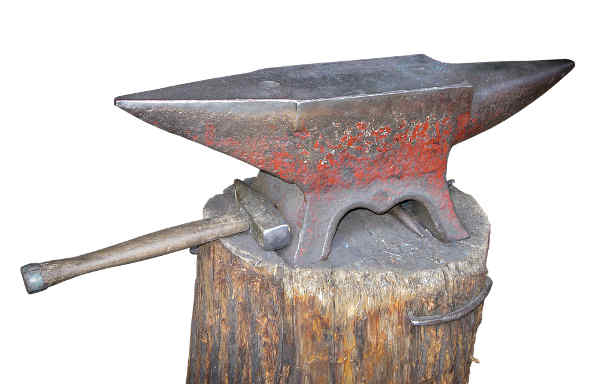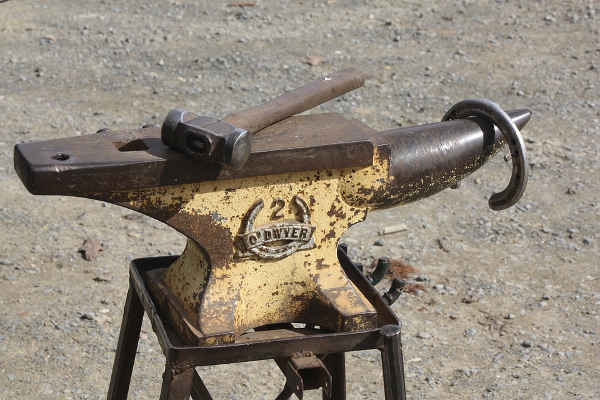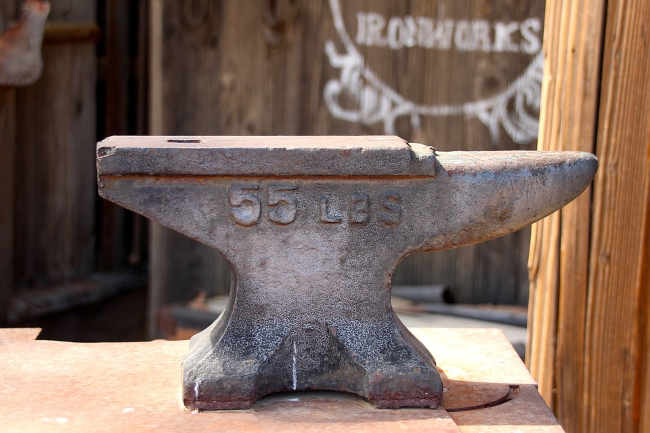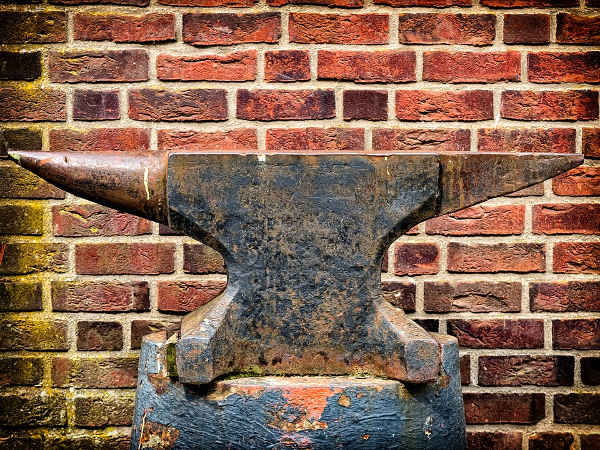If you’ve just bought your first anvil, you might be wondering how to repair or restore it. Most anvils are bought used and come with cracks, dents, and chips from years of use.
How do you repair an anvil? The most common ways to repair or restore an anvil are by either grinding down the surface, welding any missing areas, or both. However, if you’re a brand new blacksmith then trying to repair your first anvil can often do much more harm than good.
If your anvil only has minor damage, try working around it. If an anvil you’re considering buying has significant damage, maybe you should just move on and find another anvil instead.
In this article I’ll explain why you might want to repair an anvil. I’ll go into detail about why repairing an anvil isn’t always a great idea, as well as discussing some ways to fix cracks and edges if you decide to go ahead with it. Finally, I’ll share some tips to help care and maintain your anvil to keep it in good condition for years to come.
Why Would An Anvil Need Repair?
There are many reasons why an anvil may legitimately need repair, as well as reasons why people might think an anvil needs to be repaired when that isn’t really the case.
Chips, cracks, grooves, pitting, and dents can make an old anvil look really worn and damaged. But in many cases, the damage is purely aesthetic and won’t really impact your work.
The main areas where new blacksmiths might be worried about damage on their anvil is the face (the flat top surface where most of your blacksmithing work is done), and the horn (where most bending work is done.)
Blacksmiths might also worry about rust or patina on their anvils and want to remove it as well.

Anvils Are Somewhat Self-Repairing If You Just Use Them
A lot of minor imperfections in your anvil will get naturally worked out just by using your anvil.
Sharp edges will start to get worn smooth. And hot steel will quickly start to remove rust from your anvil.
Sometimes the best way to fix small damage or imperfections in your anvil is just to start using it. The constant pounding and heat will really start to make everything pretty flat and uniform before long.
Think Carefully: Do You Really NEED To Repair It?
Like I said earlier, chances are that trying to fix your anvil will do more harm than good.
If you try to “fix” it and screw up, it can be a lot harder to “un-fix” it later on.
Most anvils still have plenty of working life left in them without any kind of repairs.
Good blacksmithing isn’t about using tools that are in pristine condition, it’s all about your skill as a blacksmith. A master blacksmith can make do even with sub-par tools.
Even if you spend the time and money to get your anvil welded up right, you’re likely to still damage and chip it again as a new blacksmith while you’re still learning.
Minor Restoration Work
If you just want to clean your anvil up and make it look a bit nicer, I’d recommend taking a wire brush to it and removing some of the rust from the surface. This can give your anvil a more iron/steel color. Although I’d still probably leave the face of the anvil and allow hot metal and scale to naturally remove any rust or patina through use.
To make your cleaning job easier, you might want to consider giving your anvil a bath in vinegar to clean it off a bit before you start. You’ll need a large plastic tub with a lid, several bottles of vinegar, and likely an engine hoist or something to lift your anvil up. Place your anvil in the tub of vinegar, making sure it’s completely covered, and let it soak with the lid on for about 48 hours. Then it will be much easier to clean off with a wire brush afterward.
Don’t worry about edges until you’ve had a significant amount of experience with an anvil. If you really need sharp edges for your work, it might be easier to make a hardie tool with good edges instead. In fact, you don’t really want sharp edges as they’re more likely to chip and can also cause cold shuts in your work.
You can also put a light coat of oil or wax on your anvil to prevent further rusting.
DON’T take sandpaper or a grinder to your anvil if you don’t know what you’re doing. If you mess up the hardened top of your anvil, it will only be good as a garden ornament! The steel face of your anvil is what provides it with decades of working life.
Don’t even worry if the face of your anvil isn’t perfectly flat. Most old anvils are a bit concave (the depression is called a “swale”), and they’ll work just fine. If you really need to straighten a piece of metal, a block of wood and a mallet often does a better job anyway.

Fixing A Cracked Anvil
If you want to fix a cracked anvil, the basic steps you’ll need to take are to sand it down, grind down the cracks a bit, and weld it.
You want to grind all the surfaces you’re going to weld to expose good, clean material. Make sure to get into any fractured chips or folds.
If the crack is 3D and goes more than 8 cm deep, your anvil is most likely too damaged to really be repaired into a good working state again. It’s not going to be useful for your blacksmithing unless you were able to completely reforge it.
If your anvil just has a small crack that you want to prevent from spreading any further, that’s possible too. You can drill a hole at each end of the crack and that should stop it from getting any worse.
Use a good build-up rod for welding. Avoid hard surfacing electrodes. If you put multiple layers of hard surface on your anvil, there’s a good chance that pieces will fly off your anvil while you’re using it.
If you’re not sure if your anvil is steel or cast iron, you can use a grinder to find out. If it gives off very few sparks it’s cast iron. If there are lots of sparks, then it’s steel.
Heating Your Anvil
Before you weld your anvil, you want to heat it up to between 350 and 450 degrees first. You can use a Tempil Stick to verify the temperature.
Lifting a full-sized anvil can be hard, so you can use a more portable tool like a propane-fired weed burner to heat your anvil up.
You can also use a wood fire. But if you put your anvil directly into a fire, be sure to use a wire brush to remove all smoke deposits and carbon before you weld it.
Be aware that the hardy hole and heel area of your anvil has a thinner cross-section and it will heat faster than the larger and more solid areas.
Fixing Edges
When you heat up the edge of your anvil it may reduce hardening, but that’s fine.
Hardness means you’re more likely to chip your anvil during use, so it’s okay if your edge is a bit softer. That’s actually probably preferred for new blacksmiths.
Fixing the edges of your anvil is pretty much the same process as filling in cracks.
Bring your anvil up to around 350 or 400 degrees.
Weld your edges using a rod specifically made for building up worn parts on heavy equipment. These kind of welds will have really good impact resistance.
After you’re done welding, you can pein the welds. This helps relieve some of the tension as the metal cools off.
Once the metal is cool, you can grind it flat and smooth. And finally give it a bit of a polish.
Cooling Down Your Anvil
Quenching your anvil can be difficult and dangerous to do. You’d likely need a steel drum or something of similar size to do it.
A better option is to pack your anvil in vermiculite, which is made of crushed up mica. You can find it at the majority of garden centers and nurseries. It will allow your anvil to slowly cool over about eight hours. That way there’s less chance of stress cracking and other problems as a result of your welding.
Getting The Right Finish
When you’re starting off, use a 24-grit cup stone if you need to aggressively remove a good amount of metal. Be sure to hold it flat. You’ll know it’s flat if you’ve got sparks coming off both sides of the cup stone.
After an initial grind, move on to flex back metal sanding disks. You want to start at about 24 grit and work your way down to 240 grit over the course of 5 or 6 steps.
As I mentioned earlier, sharp edges can actually be bad on your anvil as they’re prone to chipping. So I’d recommend using a 100 grit or finer sanding disk to radius the edges.
For final polishing, you can use a Scotch Brite disk. This will get your anvil so shiny that you’ll usually be able to see your reflection in it!
Potential Risks Of Repairing An Anvil
As I’ve said already, repairing your anvil isn’t without risks. If you aren’t careful, you could end up doing more damage. Such as:
- You can spend a lot of time and money and make your anvil worse off than it was originally
- Making the face more brittle and prone to cracking in welded areas
- Heating the face of the anvil can ruin its temper in all areas in contact with the weld bead
- Edges of your anvil won’t be able to hold up to heavy use and will start to chip out or deform
But ultimately it’s up to you to decide if it’s worth it.

Maintaining And Caring For Your Old Anvil
Here are some things you can do to keep your anvil in good condition for as long as possible.
- It’s helpful to warm your anvil up a bit before using it. Cold metal is more likely to break when hit. If you can’t keep your anvil in a worm room, then warm it up by laying pieces of hot iron, a heat lamp, an electric blanket, or something similar on top to warm it up a bit before use. It takes a while to warm up a cold anvil, so don’t expect this to be done in just a couple of minutes. Also avoid heating your anvil above 250 degrees F, as it could ruin the hardness of your anvil’s face.
- Use hammers that are softer than your anvil’s face. Hitting one piece of hardened steel with another can cause sharp pieces of metal to fly off of either your hammer or anvil. You can do some serious damage. It’s also generally a smart idea to avoid hitting the face of your anvil with a hammer directly. Especially on the tips of the horn or on its edges. Keep some hot iron between your hammer and the anvil. Hot iron alone is soft and typically doesn’t damage anvils. It’s only when you hit the anvil face with cold steel that it can chip or break.
- Be especially careful on the very tip of your anvil’s horn. These small areas are prone to bending, breaking, or mushrooming if they’re repeatedly struck with heavy hammer blows. The edges of your anvil are also especially weak areas. All anvils will suffer some kind of edge damage over time.
- Generally you want to use a hammer or sledge that’s less than 1/50th the weight of your anvil. So if you’re using a 150 lb anvil, you don’t really want to use a hammer heavier than 3 lbs. Some people use a 1/30 rule instead of 1/50, but for beginners who aren’t confident with their swing yet I’d err on the side of caution.
- You can use WD40, wax, or similar items to keep your anvil rust-free and smooth. Anvils can rust when they come into contact with water or dampness if not protected. However, sometimes an anvil that’s too shiny and slick can be more difficult to use than one with a mild rust or patina on it.
- Leaving objects on your anvil can cause condensation during changes in temperature, especially in high humidity. Don’t store items on your anvil when it’s not in use. It can also be a good idea to cover your anvil with a cotton towel when not in use. A towel will keep grit, dust and other stuff off your anvil that could attract moisture.
- You can take out small dents and dings in the face of your anvil by lightly striking around them with the rounded end of a ball pein hammer.
What If I Just Want My Anvil For Decoration?
If you don’t plan to use your anvil for actual blacksmithing and just plan to use it as a lawn ornament or for a table, then it doesn’t really matter what you do to it.
Feel free to grind it down, sand it, or whatever you want to do to make it more aesthetically pleasing. It won’t matter to you if you maintain the hardness and temper of the anvil’s face.
You can also seal it with anything you want to prevent rusting and keep it looking shiny, even in outdoor conditions.
The only downside is that once you ruin your anvil for the sake of making it into a decoration, it can only ever be a decoration. If you ever want to re-sell it in the future, it will have less value since it likely won’t serve much purpose for actual blacksmithing at that point. To use it again, you’d likely need to weld a new hardened steel face onto it.
Have you done any restoration work on your own anvil? Share the details in the comments section below!

